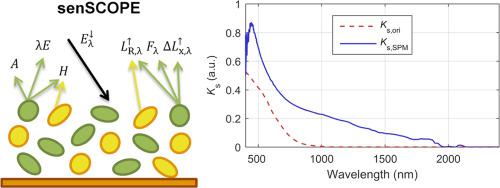Remote Sensing of Environment ( IF 13.5 ) Pub Date : 2021-02-23 , DOI: 10.1016/j.rse.2021.112352 Javier Pacheco-Labrador , Tarek S. El-Madany , Christiaan van der Tol , M. Pilar Martin , Rosario Gonzalez-Cascon , Oscar Perez-Priego , Jinhong Guan , Gerardo Moreno , Arnaud Carrara , Markus Reichstein , Mirco Migliavacca

|
The coupling of radiative transfer, energy balance, and photosynthesis models has brought new opportunities to characterize vegetation functional properties from space. However, these models do not accurately represent processes in ecosystems characterized by mixtures of green vegetation and senescent plant material (SPM), in particular grasslands. These inaccuracies limit the retrieval of vegetation biophysical and functional properties. Green and senesced plants feature contrasting spectral properties and carry out different functions that current coupled models do not represent separately. Besides, senescent pigments' absorption features change as SPM decomposes, and neither is this process well parameterized in radiative transfer models. This manuscript aims at overcoming these limitations. On the one hand, we have developed senSCOPE, a version of the Soil-Canopy Observation of Photosynthesis and Energy fluxes (SCOPE) that separately represents light interaction and physiology of green and senesced leaves. On the other, we have characterized new specific absorption coefficients of senescent pigments (Ks) from optical measurements of SPM from a Mediterranean grassland. Sensitivity analyses revealed that compared to SCOPE, senSCOPE 1) predicts variables that respond more linearly to the faction of green leaf area; and 2) keeps high levels of absorbed photosynthetically active radiation in the green leaves, which leads to significant differences in leaf photosynthesis, non-photochemical quenching, and transpiration. Moreover, we compared SCOPE vs. senSCOPE's capability to provide estimates of functional and biophysical parameters of vegetation. We assimilated different combinations of reflectance factors (R), chlorophyll sun-induced fluorescence radiance in the O2-A band (F760), gross primary production (GPP), and thermal radiance (Lt) measured in a Mediterranean grassland. Besides, we compared the role of three different sets of Ks coefficients in the inversion of senSCOPE, two estimated from SPM. The performance of the inversions was assessed using field data and a pattern-oriented model evaluation approach. Unlike SCOPE, senSCOPE provided unbiased estimates of chlorophyll content (Cab) during the dry season. The use of SPM-specific Ks improved the representation of R in the near-infrared wavelengths; and, consequently, the estimation of leaf area index (LAI). Compared with field LAI, the coefficient of determination R2 increased from ~0.4 to ~0.6, depending on the inversion constraints. Compared with SCOPE, the new model and coefficients together reduced the root mean squared error between observed and modeled R (~40%), F760 (~30%), and GPP (~5%). Both models failed to represent Lt; in this case, senSCOPE featured larger uncertainties. The modeling approach we propose improves the simulation and retrieval of vegetation properties and function in grasslands. Further work is needed to test the applicability of senSCOPE in different ecosystems, improve the simulation of the thermal spectral domain, and better characterize the optical parameters of SPM. To do so, new databases of SPM optical and biophysical properties should be produced.
中文翻译:

senSCOPE:建模混合了绿色和棕色衰老叶片的混合冠层。在地中海草原进行评估
辐射传递,能量平衡和光合作用模型的耦合为从空间表征植物功能特性带来了新机遇。但是,这些模型不能准确地表示以绿色植被和衰老植物材料(SPM)的混合物为特征的生态系统的过程,特别是草地。这些不准确性限制了植被生物物理和功能特性的获取。绿色植物和衰老植物具有鲜明的光谱特性,并具有当前耦合模型无法单独代表的不同功能。此外,衰老颜料的吸收特性会随着SPM的分解而发生变化,而且该过程在辐射传递模型中也没有得到很好的参数化。本手稿旨在克服这些限制。一方面,我们开发了senSCOPE,《土壤冠层的光合作用和能量通量观测》(SCOPE)的一个版本,分别代表绿色和衰老叶片的光相互作用和生理。另一方面,我们表征了衰老颜料的新比吸收系数(K s)来自地中海草原SPM的光学测量。敏感性分析显示,与SCOPE相比,senSCOPE 1)预测变量对绿叶面积的分配更线性地响应;2)保持绿叶中吸收的高水平光合作用活性辐射,这导致叶片光合作用,非光化学猝灭和蒸腾作用显着不同。此外,我们将SCOPE与senSCOPE的功能进行了比较,以提供植被功能和生物物理参数的估计值。我们吸收了反射因子(R),O 2 -A波段中的叶绿素太阳诱导的荧光辐射(F 760),初级生产总值(GPP)和在地中海草原上测得的热辐射(L t)。此外,我们比较了三组不同的K s系数在senSCOPE反演中的作用,其中两套是根据SPM估算的。使用现场数据和面向模式的模型评估方法评估了反演的性能。与SCOPE不同,senSCOPE提供了干燥季节叶绿素含量(C ab)的无偏估计。使用SPM特定的K s可以改善R在近红外波长中的表示;因此,估计叶面积指数(LAI)。与现场LAI比较,取决于反演约束,确定系数R 2从〜0.4增至〜0.6。与SCOPE相比,新模型和系数共同降低了观测值和建模值R(〜40%),F 760(〜30%)和GPP(〜5%)之间的均方根误差。两种模型均不能表示L t; 在这种情况下,senSCOPE具有较大的不确定性。我们提出的建模方法改善了草地植被特性和功能的仿真和检索。需要做进一步的工作来测试senSCOPE在不同生态系统中的适用性,改善对热光谱域的仿真,并更好地表征SPM的光学参数。为此,应建立有关SPM光学和生物物理特性的新数据库。



























 京公网安备 11010802027423号
京公网安备 11010802027423号